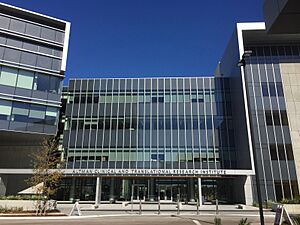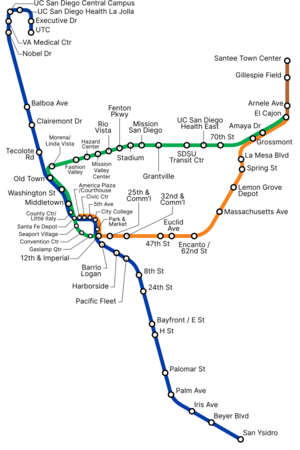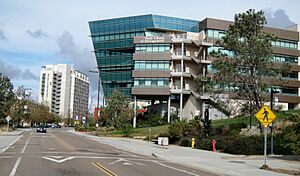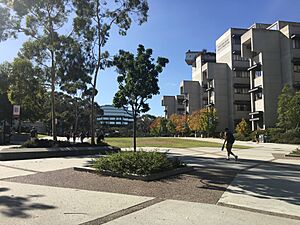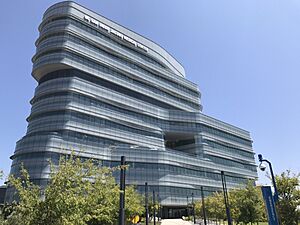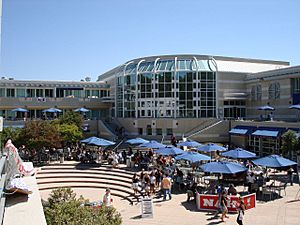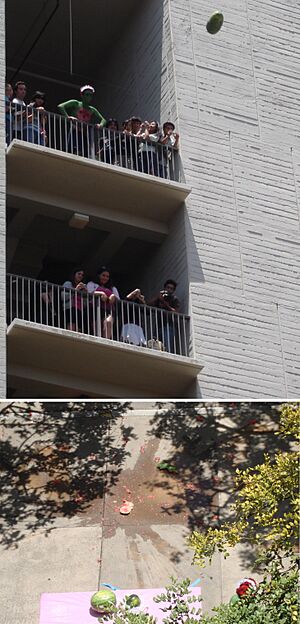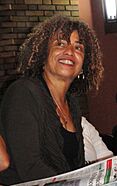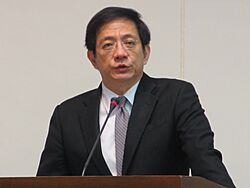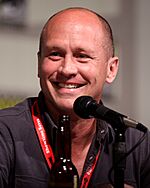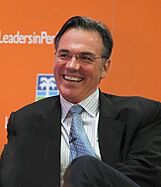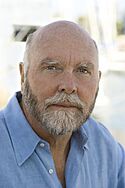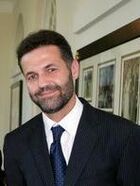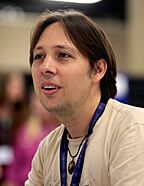University of California, San Diego facts for kids
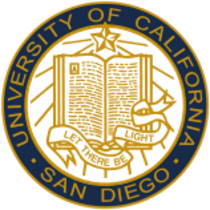 |
|
| Motto | Fiat lux (Latin) |
|---|---|
|
Motto in English
|
"Let there be light" |
| Type | Public land-grant research university |
| Established | November 18, 1960 |
|
Parent institution
|
University of California |
| Accreditation | WSCUC |
|
Academic affiliations
|
|
| Endowment | $1.36 billion (2023) |
| Chancellor | Pradeep Khosla |
|
Academic staff
|
10,810 (fall 2023) |
|
Administrative staff
|
28,878 (fall 2023) |
| Students | 43,381 (fall 2023) |
| Undergraduates | 33,792 (fall 2023) |
| Postgraduates | 9,589 (fall 2023) |
| Location |
,
United States
32°52′48″N 117°14′02″W / 32.8801°N 117.234°W |
| Campus | Large city, 2,178 acres (881 ha) |
| Newspaper | The UCSD Guardian |
| Colors | UC San Diego Navy, Blue, Yellow, and Gold |
| Nickname | Tritons |
|
Sporting affiliations
|
|
| Mascot | King Triton |
The University of California, San Diego (often called UC San Diego or UCSD) is a big public university in San Diego, California, USA. It was started in 1960 near the Scripps Institution of Oceanography in La Jolla. UC San Diego is the southernmost of the ten campuses that are part of the University of California system.
The university offers more than 200 different study programs for both undergraduate and graduate students. It has a large student body with over 33,000 undergraduate students and nearly 10,000 graduate students. UC San Diego has the second-largest student housing capacity in the entire country. The campus covers about 2,178 acres (881 hectares) near the Pacific coast.
UC San Diego has 12 schools for different subjects and 8 special living areas for undergraduate students called residential colleges. The university also has many research centers. It works closely with other important research places like the Salk Institute for Biological Studies and Scripps Research. UC San Diego is known as a "Public Ivy," meaning it's a public university that offers a high-quality education similar to the famous Ivy League schools. It's also recognized for its very high level of research activity.
Contents
History of UC San Diego
When the idea for the San Diego campus began in 1956, it was planned to be a place mainly for graduate students and research in science, math, and engineering. Local people supported this idea. They voted to give the university 59 acres (24 hectares) of land near the Scripps Institution of Oceanography. The university also asked for more land from the government.

The UC Board of Regents approved building the new campus in 1960. Herbert York, a famous scientist, became the first leader (chancellor) of the campus. He helped design the main campus. UC San Diego was the first University of California campus designed to focus heavily on research from the very beginning.
Early professors included Nobel Prize winner Harold Urey and Maria Goeppert Mayer, who later won a Nobel Prize in physics. The graduate programs started in 1960 with 20 professors. Classes were held at the Scripps Institution of Oceanography until the main campus buildings were ready.
By 1963, new buildings were finished for science and engineering. The first group of 181 undergraduate students started at Revelle College in 1964. The School of Medicine also welcomed its first students in 1966.
During the 1960s and 1970s, students at UC San Diego, like many other universities, became more involved in social issues. There were student activities and discussions about important topics of the time.
Early research at UC San Diego led to major discoveries. These include the Keeling Curve, which showed how carbon dioxide levels in the atmosphere were quickly increasing, giving early evidence for climate change. Other important work included the Kohn–Sham equations in chemistry and the Miller–Urey experiment which explored how life might have begun.
Engineering, especially computer science, grew very important at the university. Researchers helped create UCSD Pascal, an early computer language, and contributed to the National Science Foundation Network, which was an early version of the Internet.
From 1980 to 1995, under Chancellor Richard C. Atkinson, the university worked closely with San Diego businesses. This helped San Diego become a leader in technology. The Jacobs School of Engineering grew a lot during this time. The number of students also doubled to about 18,000.
In the 2000s, UC San Diego continued to grow. New schools like the Skaggs School of Pharmacy and the Rady School of Management were built. The university also became the first in the western United States to raise over $1 billion in donations by 2007.
In 2017, the university announced that its sports teams would move from NCAA Division II to NCAA Division I starting in 2020. This was a big step for the athletic programs.
In 2024, there were student activities on campus related to global events. The university worked to manage these events and ensure safety.
Campus Life and Buildings
UC San Diego is located in La Jolla, a neighborhood in northern San Diego. The main campus has 761 buildings and covers 1,152 acres (466 hectares). The San Diego Freeway runs through the campus, separating some parts like the Jacobs Medical Center from the main area. The Preuss School, a special high school run by UC San Diego, is also on campus.
At the center of the university is the famous Geisel Library. It's named after Dr. Seuss because his wife, Audrey Geisel, gave a large donation. Library Walk is a busy path that goes from the library to Gilman Drive. It's near the Price Center, which is a main student hub.
The campus is designed around the library, with eight residential colleges surrounding it: Revelle College, Muir, Marshall, Warren, Roosevelt, Sixth, Seventh, and Eighth. Each college has its own student housing and a unique architectural style.
Besides academic buildings and housing, the campus has beautiful eucalyptus groves, the Birch Aquarium, and several important research centers. The Scripps Institution has its own seaport and research ships for studying the ocean. The university also has large shake facilities for earthquake simulations.
UC San Diego works hard to be environmentally friendly. It has received high ratings for its efforts to reduce carbon emissions and save energy.
Academic Buildings
When the campus first opened in 1964, it only had Revelle College and the Scripps Institution of Oceanography. As more students joined, the campus grew quickly. Muir, Marshall, and Warren Colleges were built from the late 1960s to the 1980s.
The engineering departments became the Jacobs School of Engineering in 1982, named after Qualcomm founder Irwin M. Jacobs. New buildings have been added as this school expanded, including the San Diego Supercomputer Center and the Powell-Focht Bioengineering Hall. Other new buildings were added in the northern part of campus, like the School of Global Policy and Strategy and the Rady School of Management.
Arts and Culture on Campus
UC San Diego has a special area for arts called the Joan and Irwin Jacobs Theatre District. It shares facilities with La Jolla Playhouse, a professional theater group that has won awards. They use four large venues for plays and musicals. Many shows that start here later go to Broadway.
Other arts buildings include the Mandeville Auditorium and the Conrad Prebys Music Center for music, and various buildings for visual arts. In 2022, the Epstein Family Amphitheater opened. It's an outdoor venue for concerts and performances.
Public Art and Sculptures
The campus is decorated with more than a dozen public art projects, which are part of the Stuart Collection. These include:
- Sun God: A large winged statue by Niki de Saint Phalle.
- Fallen Star: A house that looks like it landed on top of an engineering building.
- Snake Path: A path shaped like a coiling snake, leading to Geisel Library, with a quote from John Milton's Paradise Lost.
- A giant teddy bear made of six boulders by Tim Hawkinson.
Artists like Shepard Fairey (known for the "Hope" poster) and Mario Torero have painted murals on campus buildings, especially at the Ché Café. These murals often feature important historical and political figures.
Getting Around Campus
UC San Diego has about 17,000 parking spaces. It also offers many ways to get around without a car. The university has a free shuttle system for students and staff that goes around campus and to nearby research centers. Some shuttles use biodiesel fuel. In 2023, electric shuttles started running on one route.
Since November 2021, students can also use the San Diego Trolley. The Blue Line was extended to the campus, with two stations: UC San Diego Health La Jolla and UC San Diego Central Campus station. This helps reduce traffic and makes it easier for students to travel. All students can use MTS buses and trolleys by paying a transportation fee.
New Buildings and Construction
UC San Diego is always building new facilities. Currently, several "Living and Learning Neighborhoods" are being built. These areas will have student housing, classrooms, dining halls, and sometimes underground parking.
The first neighborhood, North Torrey Pines Living and Learning Neighborhood, opened in 2020. It mainly houses students from Sixth College.
Three more neighborhoods are being built:
- The Theatre District Living and Learning Neighborhood: Expected to open in late 2024, it will house about 2,000 undergraduate students and be the home of Eighth College.
- The Pepper Canyon West Living and Learning Neighborhood: Expected to open in Fall 2024, it will house 1,300 transfer and upper-division students.
- The Ridge Walk North Living and Learning Community: Expected to finish between Fall 2025 and Winter 2026, it will house 2,400 undergraduate students, mostly from Thurgood Marshall College.
A new Triton Center is also being built near University Center. It will have student services and an Alumni & Welcome Center, opening in Winter 2026. The university also plans to add housing for 6,000 more students in the future.
Academics and Learning
UC San Diego is a large public research university. It offers four-year Bachelor of Arts and Bachelor of Science degrees. Most students are full-time undergraduates. The university has 125 bachelor's degree programs in five main areas: arts and humanities, biological sciences, engineering, math and physical sciences, and social sciences. Students can also create their own special majors.
UC San Diego has many graduate programs and professional schools, including:
- Scripps Institution of Oceanography (started 1903)
- School of Medicine (started 1968)
- School of Global Policy and Strategy (started 1986)
- Jacobs School of Engineering (started 1964)
- Rady School of Management (started 2001)
- Skaggs School of Pharmacy (started 2002)
The university offers 35 master's programs, 47 doctoral programs, and joint programs with San Diego State University. UC San Diego is known for its strong graduate programs in biological sciences, medicine, economics, physics, and computer engineering.
The UC San Diego Division of Extended Studies offers programs for continuing education. About 50,000 people take courses here each year. They can earn professional certificates in many fields like business, engineering, and technology.
Residential Colleges
UC San Diego's undergraduate students are part of eight residential colleges. Each college has its own leader (provost), sets its own general education requirements, and has its own staff to help students. The colleges are:
- Revelle College (1964): Focuses on a "Renaissance education" with strong requirements in humanities.
- John Muir College (1967): Emphasizes "self-sufficiency and individual choice" with flexible requirements.
- Thurgood Marshall College (1970): Focuses on "scholarship, social responsibility" and understanding one's role in society.
- Earl Warren College (1974): Encourages students to balance their main major with two other "programs of concentration."
- Eleanor Roosevelt College (1988): Focuses on global studies and encourages studying abroad.
- Sixth College (2001): Explores connections between culture, art, and technology.
- Seventh College (2020): Its theme is "A Changing Planet," focusing on environmental topics.
- Eighth College (2021): Its theme is "Engagement & Community," focusing on solving local and global issues.
Students choose a college based on its philosophy, not their major. Students can live in any college's housing, not just their own.
Research at UC San Diego
UC San Diego is a top research university. The Nature Index ranks it 8th in the United States for research. In 2021, the National Science Foundation ranked UC San Diego 7th among American universities for research spending, with $1.42 billion.
The university has many research centers, including the Center for Astrophysics and Space Sciences (CASS). It also works closely with the nearby Scripps Research and Salk Institute for Biological Studies. In 1977, UC San Diego created the UCSD Pascal programming language.
The San Diego Supercomputer Center (SDSC) was founded in 1985. It provides powerful computers for scientific research. In 2000, UC San Diego teamed up with UC Irvine to create the Qualcomm Institute. This institute researches areas like wireless communication to solve problems in energy, health, and the environment.
UC San Diego also runs the Scripps Institution of Oceanography (SIO), which is one of the world's largest centers for earth science research. SIO was even around before the university itself!
University Rankings
UC San Diego is highly ranked among universities both in the U.S. and globally.
- Academic Ranking of World Universities ranks UC San Diego 5th as a Best Public University and 18th in the world.
- U.S. News & World Report's 2025 rankings place UC San Diego 29th among national universities in the U.S. and 6th among public universities.
- Times Higher Education World University Rankings ranked UC San Diego 34th in the world in 2025.
- The university is also recognized as a Public Ivy.
Many of UC San Diego's specific programs are also highly ranked:
- The School of Medicine is ranked among the top for research and primary care.
- The Rady School of Management is highly ranked for faculty research and for helping alumni become entrepreneurs.
- Doctoral programs in biological sciences, bioengineering, and oceanography are ranked 1st in the nation by the National Research Council.
- The graduate theatre program is consistently ranked among the top drama schools by The Hollywood Reporter.
Admissions
UC San Diego is a very selective university. For the fall 2022 admissions, over 131,000 students applied for freshman admission. Only about 23.7% of those students were offered admission.
Student Life at UC San Diego
The university offers many activities for students, including orchestras, sports, and over 550 student clubs. About 20% of students are part of Greek organizations (fraternities and sororities). The school year is divided into three main quarters: fall, winter, and spring.
The student government, called Associated Students of the University of California, San Diego (ASUCSD), helps organize many events. They also run student media like Triton Television and the KSDT radio station. The Guardian is the student newspaper.
The Price Center is the main student gathering spot on campus. It has restaurants, the bookstore, a movie theater, and offices for student groups. It was expanded in 2008. There are also seven community resource centers on campus that support different student groups, like the Cross-Cultural Center and the LGBT Resource Center.
The Ché Café is a unique student-run place known for hosting underground music shows and being a vegan cafe. Many famous bands and artists have played there. It's also a place for art shows and film screenings.
Campus Traditions
Students at UC San Diego enjoy many traditions throughout the year.
- Welcome Week: At the start of the fall quarter, new students are introduced to campus clubs and activities.
- Hullabaloo: A music festival held every November.
- Bear Garden: A carnival held near Price Center each quarter.
- The Loft: A performance lounge in Price Center that hosts frequent events.
- Sun God Festival: Named after the famous statue, this is one of the biggest annual events in mid-May, featuring music, art, and dance.
- Watermelon Drop: An old tradition at the end of the spring quarter. Students drop a watermelon from the top of Revelle's Urey Hall and measure how far the pieces fly!
Student Housing
UC San Diego has eight undergraduate residential colleges, each with its own housing. First-year students usually live in residence halls, while older students live in college apartments. Transfer students have their own separate housing area called The Village at Pepper Canyon. The housing buildings have modern or brutalist architectural styles. Most new freshmen and many other undergraduates live on campus.
The university offers special housing for students with specific needs, like gender-neutral housing. International House, located in Eleanor Roosevelt College, is a special community for American and international students to learn about different cultures.
UC San Diego's dining facilities are known for being very vegan-friendly. As of 2025, most students living on campus are required to buy a dining plan.
As of 2024, UC San Diego had 22,000 beds for students, which is the second-highest capacity in the United States. The university guarantees two years of housing for new freshmen and transfer students, and plans to offer four years of guaranteed housing in the future.
Greek Life
UC San Diego has a large Greek community with many fraternities and sororities. These groups do not have their own houses on campus.
Sports and Athletics
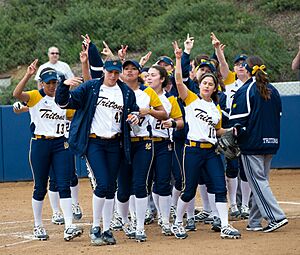
On November 27, 2017, UC San Diego announced that its sports programs would move from NCAA Division II to NCAA Division I. This change was completed on July 1, 2020. UC San Diego is now a member of the Big West Conference.
The university has 23 intercollegiate varsity athletic teams, called the Tritons. They compete in various sports like baseball, basketball, soccer, swimming, and volleyball. Their home facilities include the RIMAC facility, Triton Ballpark, and LionTree Arena.
UC San Diego athletics has won a total of 30 national championships in sports like golf, soccer, softball, tennis, volleyball, and water polo. The 2006–07 season was one of their best, with 19 teams making it to post-season competitions.
In 2007, students voted to approve a fee that would help fund athletic scholarships for all 600 intercollegiate athletes. This allowed the university to meet NCAA requirements.
In 2016, students voted again to support the move to NCAA Division I. This showed strong student support for the athletic programs.
The university also has 30 sports club teams, including badminton, cycling, ice hockey, rugby, and surfing. The UC San Diego surf team has won the national championship six times and is one of the best in the U.S. UC San Diego does not have a football team.
University Leaders
List of Chancellors
The following people have served as the leader (chancellor) of UC San Diego:
| No. | Portrait | Chancellor | Term start | Term end | Notes |
|---|---|---|---|---|---|
| 1 |  |
Herbert York | February 18, 1961 | November 30, 1964 | |
| 2 |  |
John Semple Galbraith | December 1, 1964 | June 20, 1968 | |
| 3 |  |
William J. McGill | June 21, 1968 | August 31, 1970 | |
| Acting |  |
Herbert York | September 1, 1970 | January 31, 1972 | |
| 4 |  |
William D. McElroy | February 1, 1972 | June 30, 1980 | |
| 5 |  |
Richard C. Atkinson | July 1, 1980 | September 30, 1995 | Atkinson left UCSD to become UC president |
| Interim |  |
Marjorie Caserio | October 1, 1995 | June 30, 1996 | |
| 6 |  |
Robert C. Dynes | July 1, 1996 | October 1, 2003 | Dynes left UCSD to become UC president |
| Acting |  |
Marsha Chandler | October 2, 2003 | August 15, 2004 | |
| 7 |  |
Marye Anne Fox | August 16, 2004 | June 2012 | |
| 8 |  |
Pradeep Khosla | August 1, 2012 | present |
Famous People from UC San Diego
-
Angela Davis
An American professor known for her work on social justice. -
Mike Judge
A TV creator known for shows like Beavis and Butt-Head and King of the Hill. -
Billy Beane
President of the Oakland Athletics baseball team, famous for the book Moneyball. -
Craig Venter
A genomics professor known for his work on the human genome. -
Khaled Hosseini
A physician and author of novels like The Kite Runner. -
Susumu Tonegawa
A Nobel Prize winner in Medicine. -
David J. Peterson
A language creator for movies and TV shows like Game of Thrones.
UC San Diego professors, researchers, and alumni have won many important awards. These include 27 Nobel Prizes, 3 Fields Medals (for math), 8 National Medals of Science, and 4 Pulitzer Prizes. Many faculty members have also been elected to important national academies for their achievements in engineering, science, and medicine.
Images for kids
-
Panorama of the Jacobs School of Engineering on Earl Warren College mall. From left to right: Geisel Library, Engineering Building Unit (EBU) I, the Powell-Focht Bioengineering Building, the Computer Science Building, and EBU II (visible through trees)
See also
 In Spanish: Universidad de California en San Diego para niños
In Spanish: Universidad de California en San Diego para niños



